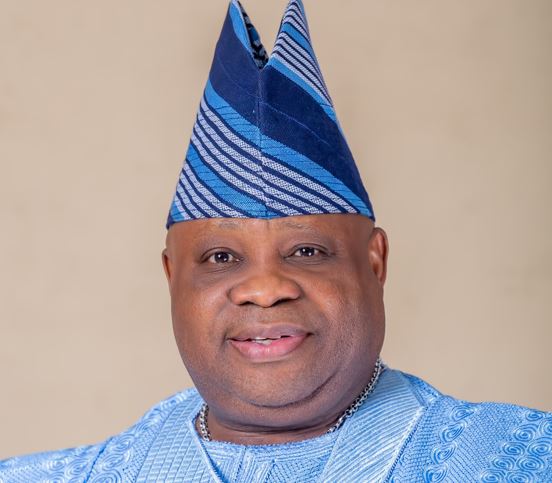
Adeleke’s leadership: A dance of transformation in Osun
By Bamikole Omishore
“Great dancers are not great because of their technique; they are great because of their passion.” – Martha Graham
In the world of dance, few have mastered the art of movement with the grace and intensity of Martha Graham, whose choreography was marked by a profound understanding of human expression and transformation. Graham’s dances were not mere performances; they were powerful reflections of the human condition, a tapestry woven with raw emotion, rhythm, and purpose. In many ways, the leadership of Osun State Governor, Ademola Adeleke, mirrors this very essence of dance—dynamic, passionate, and forward-moving.
Governor Adeleke has taken the helm of Osun State with the kind of zeal and vision that echoes the intensity of a choreographed performance, where each step is deliberate, and every movement contributes to a greater narrative of transformation. His approach to governance is not just about policy execution but about creating an environment where the people of Osun are empowered, uplifted, and given the tools to thrive. In his leadership, one sees a choreography of progress, dedication, and unwavering commitment to the welfare of his people. Considering the precarious state of Osun when he took office on November 27, 2022, Adeleke could not have done otherwise—every step had to be deliberate and tailored for the development of the people.
Much like Martha Graham’s focus on the expression of the individual within a broader context, Governor Adeleke’s leadership shines in its ability to focus on the unique needs of Osun State’s diverse communities, while also aligning them with the collective goal of the state’s development. He has taken the pulse of Osun and, much like a skilled dancer attuned to the rhythm of the music, has set a course for the state that resonates with both empathy and pragmatism. Governor Adeleke’s impact is tangible, and his passion for the people is infectious. His administration has not shied away from confronting the most pressing issues facing the state, including infrastructural deficits, educational reform, and economic revitalisation. Just as Martha Graham redefined modern dance by introducing new techniques and forms, Governor Adeleke has redefined governance in Osun by introducing innovative policies, modernising systems, and fostering an environment where growth is inevitable.
One of the cornerstones of Adeleke’s governance has been his focus on improving the education sector. Under his leadership, 631 classrooms and offices have been rehabilitated across 125 basic schools, while 323 new classrooms, halls, and laboratories have been constructed in 96 schools. Additionally new toilets, boreholes, motorised water wells, and perimeter fences have been installed in several schools. The Governor has also upgraded the Educational Management Information System (EMIS) units in local education authorities to improve data collection and management. Adeleke’s administration has sponsored 200 secondary school teachers and 20 ICT experts to train on remote learning platforms and has trained 1,004 teachers on cooperative learning strategies. The governor has also initiated the recruitment of 5,000 new teachers to address vacancies in public schools. For tertiary education, Adeleke has invested in infrastructure, including completing a 52-office complex at Osun State University (UNIOSUN), thus becoming the first Governor since 2011 to execute a project at the institution. He also funded the construction of the first student hostel at the University of Ilesa (UNILESA). He approved the permanent employment of over 230 temporary staff at UNILESA and supported the training of 137 academic staff at the Osun State College of Technology and 1,120 health educators in collaboration with international organisations. He also revived the indigenous bursary scheme, providing financial support to over 3,100 students and N105,000 to Osun indigenes in law schools across Nigeria.
Governor Adeleke’s approach to healthcare mirrors the precision and care found in Graham’s choreography. Upon taking office, he inherited a healthcare system in disarray. However, he quickly launched the Imole Surgical and Medical Outreach, which provided free medical treatment to over 50,000 residents across Osun, addressing a wide range of conditions from cataracts and hernias to diabetes, hypertension, and malaria. On a long-term basis, Adeleke’s administration has focused on improving the state’s healthcare infrastructure. This includes the rehabilitation of 345 primary healthcare centres (PHCs), with 200 already upgraded to include 24/7 power and water facilities, while the remaining 145 centres are undergoing renovations. His administration has also ensured a regular supply of medications to these centres and has partnered with development organisations to provide essential medical equipment. Governor Adeleke’s healthcare policies have expanded health insurance coverage to include informal sector workers and Osun’s senior citizens, ensuring comprehensive healthcare access for all, including persons with disabilities.
Infrastructure development has been another focal point of Adeleke’s leadership. Osun State’s infrastructure, particularly in the road sector, was in dire need of attention when he assumed office. In the past two years, his administration has constructed many roads and has embarked on additional projects to extend the state’s road network. Notable projects include the Oke-Fia overhead bridge in Osogbo, the first-ever overhead bridge in Ile-Ife, and the Akoda-Baptist-Oke Gada dual carriageway in Ede. These projects are expected to improve traffic flow, ease transportation, and spur economic growth by connecting key areas of the state. Adeleke’s commitment to infrastructure extends beyond urban centres. Under his leadership, Osun State has rejoined the Rural Access and Mobility Project (RAAMP-3), focusing on improving rural road networks. These improvements are vital for enhancing rural connectivity, facilitating trade, and providing essential access to health and education services in remote areas. The Governor’s unwavering passion for the people of Osun is also evident in his economic policies, which are focused on stimulating local industries, attracting investment, and reducing unemployment. Like Martha Graham’s ability to tap into the emotional core of her dancers, Adeleke’s governance taps into the heart of Osun’s potential, nurturing the state’s resources, businesses, and talents.
Governor Adeleke is driving sustainable development in Osun State with initiatives that align with the Sustainable Development Goals (SDGs). At the heart of his work is the Senator Isiaka Adetunji Adeleke Estate, a development that balances modern infrastructure with the need for planned, resilient communities. Governor Adeleke’s vision is not just about physical structures—it extends into the human realm. In SDG 4 (Quality Education), he has created the Alternative School for Girls, offering education to those who would otherwise be left behind.
Perhaps most importantly, Governor Adeleke’s leadership is marked by a deep sense of inclusivity and unity. Just as a dance troupe requires each member to work in harmony for the performance to succeed, Adeleke has fostered a sense of collective purpose in Osun.
Governor Ademola Adeleke has brought a new rhythm to Osun State, one driven by passion, innovation, and an unwavering commitment to the welfare of the people. Much like Martha Graham’s transformative choreography, which changed the landscape of modern dance forever, Adeleke’s governance has redefined the landscape of leadership in Osun —one that promises progress, unity, and a brighter future for all its citizens.
Omishore is a proud son of Osun state, writes from Ile-Ife




